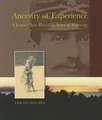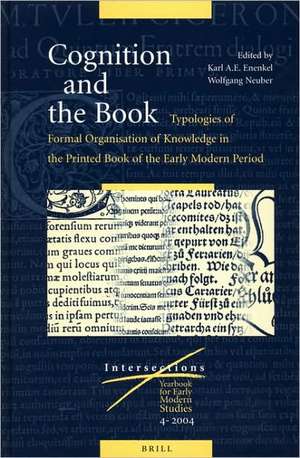Cognition and the Book: Typologies of Formal Organisation of Knowledge in the Printed Book of the Early Modern Period: Intersections, cartea 4
Karl A. E.. Enenkel, Wolfgang Neuberen Limba Engleză Hardback – 9 dec 2004
Din seria Intersections
-
 Preț: 215.61 lei
Preț: 215.61 lei -
 Preț: 200.26 lei
Preț: 200.26 lei -
 Preț: 154.86 lei
Preț: 154.86 lei -
 Preț: 192.18 lei
Preț: 192.18 lei -
 Preț: 98.61 lei
Preț: 98.61 lei -
 Preț: 217.51 lei
Preț: 217.51 lei -
 Preț: 116.09 lei
Preț: 116.09 lei - 18%
 Preț: 1074.49 lei
Preț: 1074.49 lei -
 Preț: 241.64 lei
Preț: 241.64 lei -
 Preț: 241.64 lei
Preț: 241.64 lei -
 Preț: 228.96 lei
Preț: 228.96 lei -
 Preț: 229.55 lei
Preț: 229.55 lei -
 Preț: 241.64 lei
Preț: 241.64 lei -
 Preț: 226.67 lei
Preț: 226.67 lei -
 Preț: 107.21 lei
Preț: 107.21 lei -
 Preț: 208.79 lei
Preț: 208.79 lei -
 Preț: 201.78 lei
Preț: 201.78 lei -
 Preț: 226.85 lei
Preț: 226.85 lei -
 Preț: 225.71 lei
Preț: 225.71 lei -
 Preț: 246.63 lei
Preț: 246.63 lei -
 Preț: 228.96 lei
Preț: 228.96 lei - 47%
 Preț: 319.92 lei
Preț: 319.92 lei - 7%
 Preț: 315.66 lei
Preț: 315.66 lei -
 Preț: 96.10 lei
Preț: 96.10 lei - 18%
 Preț: 1201.75 lei
Preț: 1201.75 lei - 18%
 Preț: 659.69 lei
Preț: 659.69 lei - 18%
 Preț: 693.26 lei
Preț: 693.26 lei - 18%
 Preț: 1049.43 lei
Preț: 1049.43 lei - 18%
 Preț: 698.32 lei
Preț: 698.32 lei - 18%
 Preț: 681.99 lei
Preț: 681.99 lei - 18%
 Preț: 687.25 lei
Preț: 687.25 lei - 18%
 Preț: 820.59 lei
Preț: 820.59 lei - 18%
 Preț: 683.37 lei
Preț: 683.37 lei - 18%
 Preț: 667.86 lei
Preț: 667.86 lei
Preț: 990.57 lei
Preț vechi: 1208.01 lei
-18% Nou
Puncte Express: 1486
Preț estimativ în valută:
189.55€ • 198.40$ • 157.76£
189.55€ • 198.40$ • 157.76£
Carte indisponibilă temporar
Doresc să fiu notificat când acest titlu va fi disponibil:
Se trimite...
Preluare comenzi: 021 569.72.76
Specificații
ISBN-13: 9789004124509
ISBN-10: 9004124500
Pagini: 641
Dimensiuni: 155 x 235 x 45 mm
Greutate: 1.3 kg
Editura: Brill
Colecția Brill
Seria Intersections
ISBN-10: 9004124500
Pagini: 641
Dimensiuni: 155 x 235 x 45 mm
Greutate: 1.3 kg
Editura: Brill
Colecția Brill
Seria Intersections
Public țintă
All those interested in the history of the book, the history of literature and science, and cultural history.Cuprins
Acknowledgements
Notes on the Editors of this Volume
List of Contributors
Einleitung, Karl A.E. Enenkel & Wolfgang Neuber
THE PHYSIOGNOMY OF THE BOOK
1. The Rise of the Typographical Paragraph, Frans A. Janssen
GENRESPECIFIC ‘ERKENNTNISSTEUERUNG’
2. Locating Knowledge, Ann Moss
3. Ars Antiquitatis. Erkenntnissteuerung und Wissensverwaltung in Werken zur römischen Kulturgeschichte, Karl A.E. Enenkel
4. Die Kosmographie – Typologie und Medienstrategien, Detlef Haberland
5. Cognition in Emblematic Fable Books: Aegidius Sadeler’s Theatrum Morum (1608) and its Reception in France (1659–1743), Paul J. Smith
6. Tacit Skills in the Perspective Treatise of the Late Renaissance, Ian F. Verstegen
‘ERKENNTNISSTEUERUNG’ IN THE EDITIONS OF CERTAIN AUTHORS
7. Credit, Paratexts, and Editorial Strategies in Erasmus of Rotterdam’s Editions of Jerome, Hilmar M. Pabel
8. Der „rhetorisierte“ Longin. Medienstrategien zur „Klassierung“ eines Autors, Dietmar Till
9. Strategien der Wissensvermittlung und Rezeptionssteuerung in Inkunabeln und Drucken zum Buch der Natur Konrads von Megenburg, Robert Luff
‘ERKENNTNISSTEUERUNG’ IN THE ILLUSTRATED BOOK
10. Bilder als Mittel der Erkenntnissteuerung. Text und Bild in Boccaccios Decameron, Ursula Kocher
11. Der geschlachtete Kannibale. Zu einigen niederländischen Ausgaben von Hans Stadens Reisebericht, Wolfgang Neuber
12. Illustration, Dekoration und das allmähliche Verschwinden der Bilder aus dem Roman (1471–1700), Manuel Braun
13. Typographisches Decorum. Ordnung und Éclat in der Typographie der höfischen Figurendichtung und Festbeschreibung, Thomas Rahn
14. „Alles/was hierniden ist/das ist auch droben“. Zur Funktion graphischer Systemdarstellungen in Buch-Publikationen aus dem Bereich der magia naturalis (Robert Fludd, Oswald Croll), Maximilian Bergengruen
‘ERKENNTNISSTEUERUNG’ IN RELIGIOUS TEXTS
15. Deutschsprachige Andachtsbücher um 1500. Drucke zwischen Wissensvermittlung und Meditationshilfe, Romy Günthart
16. Typographische Erkenntnissteuerung in Handschrift und Druck: Der illustrierte „Geistliche Rosengarten“ in einer spätmittelalterlichen Handschrift und in einem Druck, Jörg Jungmayr
17. Techniken der Leserlenkung und -selektion im volkssprachigen Buch der Gegenreformation Um 1600, Kai Bremer
THE CASE OF DESCARTES
18. Abbilden und Überzeugen bei Descartes, Claus Zittel
19. The Relationship between Word and Image in Books on Medicine in the Early Modern Period, Matthijs van Otegem
List of Illustrations
Index Nominum
Notes on the Editors of this Volume
List of Contributors
Einleitung, Karl A.E. Enenkel & Wolfgang Neuber
THE PHYSIOGNOMY OF THE BOOK
1. The Rise of the Typographical Paragraph, Frans A. Janssen
GENRESPECIFIC ‘ERKENNTNISSTEUERUNG’
2. Locating Knowledge, Ann Moss
3. Ars Antiquitatis. Erkenntnissteuerung und Wissensverwaltung in Werken zur römischen Kulturgeschichte, Karl A.E. Enenkel
4. Die Kosmographie – Typologie und Medienstrategien, Detlef Haberland
5. Cognition in Emblematic Fable Books: Aegidius Sadeler’s Theatrum Morum (1608) and its Reception in France (1659–1743), Paul J. Smith
6. Tacit Skills in the Perspective Treatise of the Late Renaissance, Ian F. Verstegen
‘ERKENNTNISSTEUERUNG’ IN THE EDITIONS OF CERTAIN AUTHORS
7. Credit, Paratexts, and Editorial Strategies in Erasmus of Rotterdam’s Editions of Jerome, Hilmar M. Pabel
8. Der „rhetorisierte“ Longin. Medienstrategien zur „Klassierung“ eines Autors, Dietmar Till
9. Strategien der Wissensvermittlung und Rezeptionssteuerung in Inkunabeln und Drucken zum Buch der Natur Konrads von Megenburg, Robert Luff
‘ERKENNTNISSTEUERUNG’ IN THE ILLUSTRATED BOOK
10. Bilder als Mittel der Erkenntnissteuerung. Text und Bild in Boccaccios Decameron, Ursula Kocher
11. Der geschlachtete Kannibale. Zu einigen niederländischen Ausgaben von Hans Stadens Reisebericht, Wolfgang Neuber
12. Illustration, Dekoration und das allmähliche Verschwinden der Bilder aus dem Roman (1471–1700), Manuel Braun
13. Typographisches Decorum. Ordnung und Éclat in der Typographie der höfischen Figurendichtung und Festbeschreibung, Thomas Rahn
14. „Alles/was hierniden ist/das ist auch droben“. Zur Funktion graphischer Systemdarstellungen in Buch-Publikationen aus dem Bereich der magia naturalis (Robert Fludd, Oswald Croll), Maximilian Bergengruen
‘ERKENNTNISSTEUERUNG’ IN RELIGIOUS TEXTS
15. Deutschsprachige Andachtsbücher um 1500. Drucke zwischen Wissensvermittlung und Meditationshilfe, Romy Günthart
16. Typographische Erkenntnissteuerung in Handschrift und Druck: Der illustrierte „Geistliche Rosengarten“ in einer spätmittelalterlichen Handschrift und in einem Druck, Jörg Jungmayr
17. Techniken der Leserlenkung und -selektion im volkssprachigen Buch der Gegenreformation Um 1600, Kai Bremer
THE CASE OF DESCARTES
18. Abbilden und Überzeugen bei Descartes, Claus Zittel
19. The Relationship between Word and Image in Books on Medicine in the Early Modern Period, Matthijs van Otegem
List of Illustrations
Index Nominum
Notă biografică
Karl Enenkel teaches Latin and Neo-Latin literature in the Department of Classics, Leiden University. He is the author of Francesco Petrarca: De vita solitaria, Buch 1. Kritische Textausgabe und ideengeschichtlicher Kommentar (1990), Kulturoptimismus und Kulturpessimismus in der Renaissance (1995), and numerous articles on Italian and Dutch humanism.
Wolfgang Neuber, Ph.D. (1980) in Philosophy, University of Vienna, is Professor of Early Modern German Literature at Freie Universität Berlin. He has published extensively on the history of rhetoric, on travel accounts and on mnemonics.
Wolfgang Neuber, Ph.D. (1980) in Philosophy, University of Vienna, is Professor of Early Modern German Literature at Freie Universität Berlin. He has published extensively on the history of rhetoric, on travel accounts and on mnemonics.
Descriere
The printed book, the most important invention of the early modern period, brought about not only an explosion of knowledge, but also major changes in the perception of texts. This volume investigates the methods by which knowledge was presented to the early modern reader and the organisation of material that guided his cognition of them. It focuses not merely on book-historical questions, but on the intersection of layout and paratexts with issues of genre, content and intended function of texts. A team of experts in various disciplines, English, French, German, Neo-Latin, philosophy, art history, the history of science and book history, makes a first effort to understanding this fascinating topic.
Contributors include: Maximilian Bergengruen, Manuel Braun, Kai Bremer, Karl A.E. Enenkel, Romy Günthart, Detlef Haberland, Frans A. Janssen, Jörg Jungmayr, Ursula Kocher, Robert Luff, Ann Moss, Wolfgang Neuber, Matthijs van Otegem, Hilmar M. Pabel, Thomas Rahn, Paul J. Smith, Dietmar Till, Ian F. Verstegen, and Claus Zittel.
Contributors include: Maximilian Bergengruen, Manuel Braun, Kai Bremer, Karl A.E. Enenkel, Romy Günthart, Detlef Haberland, Frans A. Janssen, Jörg Jungmayr, Ursula Kocher, Robert Luff, Ann Moss, Wolfgang Neuber, Matthijs van Otegem, Hilmar M. Pabel, Thomas Rahn, Paul J. Smith, Dietmar Till, Ian F. Verstegen, and Claus Zittel.
